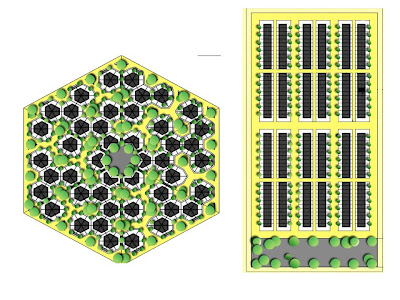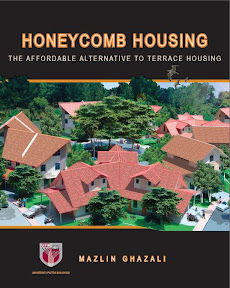Protection from Climate
Safety concerns met, a need that then comes into focus is comfort. In Malaysia, as in many tropical countries, and in temperate countries with hot summers, outdoor thermal comfort is an important consideration.
Many cities suffer from overheating, whereby the ambient air temperature in suburban and downtown urban areas can be 2 to 3 degrees Celsius hotter than in rural areas. This is termed the urban heat island effect and is caused by fewer plants and trees and the greater absorption of solar radiation by more buildings and roads. These temperature increases, although seemingly small from an engineering viewpoint, have profound effects on human comfort.
Outdoor Heat Stress
Meteorological data collected between 1975 and 1995 from the Subang weather station, Kuala Lumpur, Malaysia reveals that the average outdoor temperature in Kuala Lumpur has increased by 1.20C during this 21 year period. As shown Kuala Lumpur is getting hotter by 0.60C per decade.
This finding supports anecdotal subjective evidence from long term residents of Kuala Lumpur who claim city living is becoming more and more uncomfortable compared to the rural areas. This previously unreported data was part of a larger study to construct a Malaysian weather year, termed a Test Reference Year (Reimann et al 2000).An objective measure of heat stress imposed by the outdoor Malaysian environment during different periods of the year has been calculated from the Test Reference Year in a novel Thermal Discomfort index.
One unit of thermal discomfort is defined here as the heat stress suffered by a person wearing light tropical clothing whilst resting outdoors for one hour in the shade with no wind whilst the average ambient temperature is 10C above the upper thermal comfort level (estimated to be 280C for the Malaysian humid tropics, Davis et al 2000). For example, a person under these conditions when the average ambient temperature between 1pm and 2 pm is 330C suffers, by definition, 5 units of thermal discomfort. These units per hour, summed over 24 hours, provide a quantitative measure of human heat stress for that particular day.
The results reveal that the population of Malaysia suffers outdoor heat stress throughout the year; there is no cool season. Whilst Malaysia, being close to the equator, is hot every day of the year, this index reveals for the first time the true but rather hidden seasonality as felt by humans. Two heat-waves, imposing 40 units of thermal discomfort per day, occur regularly in March and May whilst the 4 months from September to December are much more pleasant, imposing only 15 units of thermal discomfort per day.
Indoor Heat Stress
The situation indoors is not much better. Study at UPM has shown that nearly all of the modern concrete houses built over the last 50 years in Malaysia grossly overheat (Davis et al 1995, 1997, 2002, 2003). In one example a single story concrete terrace house during a heat-wave is way above the upper thermal comfort level every minute of the night and day.
However, the outdoor environment is perfectly comfortable for 14 hours per day. Experiments such as this during different times of the year, using a miniature temperature data-logging technique (Davis et al, 1995), has established that all 2 million modern concrete houses cause two to three times more thermal discomfort (heat stress) than the outdoor environment. The general though rather sad conclusion is that the Malaysian urban population would be far more thermally comfortable if they abandoned their houses and lived under trees. This absurd situation has provided the motivation to design sustainable thermally comfortable houses which avoid or minimize the high electricity cost of air-conditioning.
Thermally Comfortable Neighbourhoods
The Honeycomb Thermal Comfort housing concept applies two approaches: firstly, the houses themselves are designed to minimize heat gain by shading, insulation and the thermal capacity of the building fabric is employed as a heat sink by cooling it at night. Secondly, applying the Honeycomb layout concept permits a very lush urban landscape in the gardens and neighbourhood parks to mitigate the heat-island effect by shading the hard external surfaces.
Our research show that this alternative design approach uses land efficiently, that there is potential to reduce infrastructure cost, and that the consumer reaction to this new concept is favourable.
The first step in combating the heat-island effect is to reduce the heat gain of the buildings themselves. This reduces the heat load of buildings and makes them more comfortable for the occupants and reduces the use of energy for air-conditioning. Preventing the thermal mass of buildings that make up the concrete jungle from heating up during the daytime is not only an effective strategy for passively achieving indoor thermal comfort in Malaysia, but it also lowers the radiation from the buildings to the outdoor environment. Happily, to the extent that this radiation contributes to the heat island effect, thermal comfort technology may also have a positive effect on external temperature.
The urban roads in Malaysia are the other major contributor to the heat island effect. The roads are surfaced in black bitumen and fully exposed to direct sunlight which optimizes the absorption of solar radiation, grossly overheats the roads and the subsurface layer of hardcore. Roads also comprise almost half the of the land area of Malaysian terrace house townships. Urban roads are therefore an enormous heat sink in Malaysia and need to be shaded from direct sunlight by canopy trees. This is not always possible in the grid land subdivision typified by terrace housing. Mainly small are trees grown along streets since their roots will be blocked by services and drains, and these trees offer virtually no shade to roads. New Malaysian housing estates are becoming increasingly like desert townships, too hot and devoid of nature.
In the Honeycomb layout, the green area in the courtyards is for big trees to be grown, undisturbed by drains or sewage pipes, providing almost complete shade to the courtyard roads as they mature to 12 to 18 meters in height. to mitigate the heat-island effect by shading the hard external surfaces (figure 10). Honeycomb housing layouts can permit a very lush urban landscape in the gardens and neighbourhood parks. The winding roads can also be tree lined to provide shade. The aim is to recreate a rainforest type canopy over the township as the trees mature over a 5 to 10 year period to reduce the heat island effect.

From our Honeycomb mathematical model, we have estimated the potential tree canopy area of the above honeycomb township to be 46%, compared to only 15% for a row housing, typical of a Malaysian terrace house township. Modifying the indoor climate is clearly achievable with existing technology, correctly applied for any particular climate and culture.
It is already well known that cul-de-sac layouts yield more saleable land compared to rectilinear grid layouts (Southworth and Joseph 2001), however cul-de-sac arrangements of ‘single-family’ detached houses cannot match the densities achieved by terrace housing. The Honeycomb layout is a cul-de-sac arrangement that allows for linked ‘multi-family’ units and can match (or even exceed) the densities achieved by terrace housing.
We have demonstrated earlier that honeycomb housing produces here greatly increased land use efficiencies. These advantages are summarized in the mathematical table comparing the terrace housing against quadruplex/sextuplex honeycomb housing in the section on tessellation maths. The density between the two is the same but the amount of road for the Honeycomb layout is only 33% against 47% for the terrace layout. Consequently, the average size of each lot is 30% larger, leaving more area for gardens. There will thus be more soft green surfaces and less hard surfaces with the ability to absorb heat.


No comments:
Post a Comment